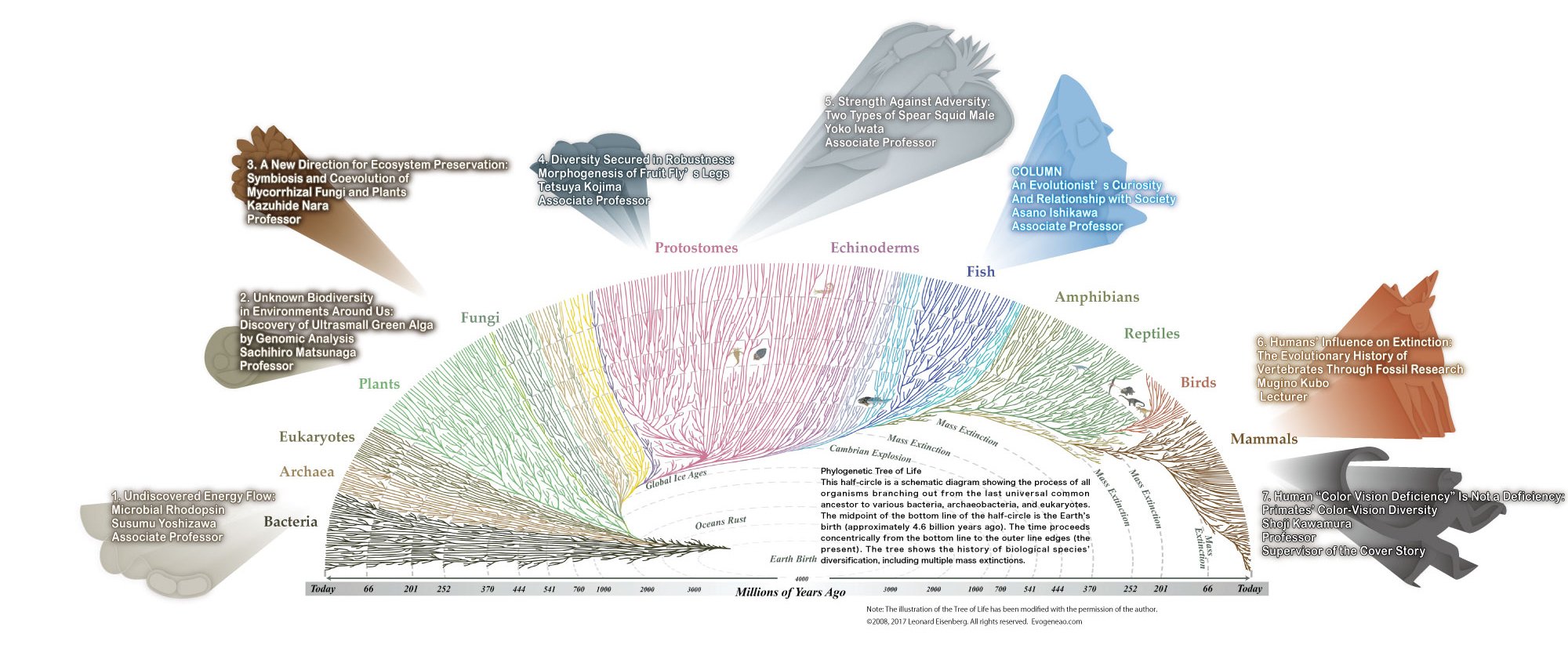The news that Professor Svante Pääbo was awarded the 2022 Nobel Prize in Physiology or Medicine gathered a lot of attention. Professor Pääbo is a researcher at the Max Planck Institute for Evolutionary Anthropology, Germany, and played a major role in establishing paleogenomics. Advancements in methodology and technology have expanded the scope of evolutionary biology research. It is no exaggeration to say that most life science is related to evolutionary biology.
Evolutionary biology is also full of suggestions for solving global problems such as climate change, the increase in endangered species, and unknown infectious disease risks. Here, we delve into the cutting-edge evolutionary research ongoing at the Graduate School of Frontier Sciences to learn the valuable insights it provides.
Interview and the original Japanese text by Kazutada Furui
What is Biological Evolution?
Currently, there are about 1.75 million species on Earth. All organisms, including undiscovered ones, evolved from one common ancestor approximately 3.8 billion years ago. Evolution is the phenomenon in which existing organisms are descended from past organisms with population-wide modification of their traits and nature throughout generations.
Shoji Kawamura, a professor in the Department of Integrated Biosciences and a former president of the Society of Evolutionary Studies, Japan, explains the process of evolution in the following way,
“Evolution is triggered by genomic mutations*1 that happen in a random fashion but continuously in individuals. Over long periods of time, the characteristics of species also change through population-wide factors such as random genetic drift*2, natural selection*3, sexual selection*4, migration, isolation, and admixture.”
Through evolution, organisms gradually diversify, from which an ecosystem is established where different species interact with one another. Diversity is the key characteristic of evolution of life.
The concept of evolution of life was first theoretically formulated by Charles Darwin. In 1859, he published On the Origin of Species, which founded evolutionary biology as a significant field in modern science, and greatly impacted society.
Nowadays, the concept of “evolution” is used widely in various topics, such as the state of society, the universe, and even for animation characters. However, “natural selection” is often taken as a value judgment about superiority and inferiority or absoluteness, and confused with “progress” or “improvement” due to the oversimplification and misunderstanding of its meaning. Therefore, it is important to know the correct meaning of evolution.
How Did Evolution Research Advance?
The study of organismal evolution was initiated by Darwin and has progressed through contributions by numerous researchers.
By around 1930, the theoretical understanding of relationships between mutations, random genetic drift, and natural selection was greatly progressed by the development of population genetics*5. At the end of the 1960s, Motoo Kimura’s “neutral theory of molecular evolution” was established. This theory promoted the understanding of the significance of the chance effect manifested by random genetic drift in the evolutionary change of DNA sequences.
During the 1970s and 1980s, evolutionary biology was further advanced by innovations of molecular biology technologies, such as DNA sequencing technology*6, recombinant DNA technology*7, and polymerase chain reaction*8.
Since the 2000s, the development of “next-generation” sequencing technologies has greatly advanced evolutionary research. The research by Professor Pääbo, the Nobel laureate of the 2022 Nobel Prize in Physiology or Medicine, is a well-known example of their application, decoding DNA extracted from the fossil bones of a Neanderthal. His research, which inferred crossbreeding between modern humans (Homo sapiens) and Neanderthals, led to the establishment of the field of paleogenomics*10.
In recent years, the emergence of paleogenomics is one of the most notable events in evolutionary research. However, other approaches have also developed the field, including environmental DNA analysis, spectroscopic analysis, live imaging technology, isotope ratio mass spectrometry, model organisms, and advanced microscopic analysis using tools such as a polarized light microscope, confocal microscope, super-resolution microscope, and trace element analysis. In the study of organismal evolution, these methods and tools can help clarify the morphology, physiology, behavior, and life cycle at cellular, individual, population, and ecosystem levels.
NOTES
1. Mutation: This term refers to errors in replication and repair of DNA strands that result in the substitution, insertion, deletion of DNA sequences, short and long duplications, translocations, and recombination.
2. Random Genetic Drift: The phenomenon that the frequency of alleles in a population changes by chance, leading to the loss or fixation of some alleles*. *Alleles are gene variants found at the same locus of chromosomes; for example, the A, B, and O alleles of the ABO blood group gene locus.
3. Natural Selection: When more and less advantageous genotypes** for survival and reproduction coexist in a population, offspring with more advantageous genotype have a higher chance of passing on those genes, leading to a shift of allele frequencies in the population: loss, fixation, or equilibrium of some alleles. **Genotype refers to the combination of two alleles in an individual; for example, the blood types of AA, AB, AO, BB, and OO.
4. Sexual Selection: Sexual selection is a process featuring competition among males for mating with females, or females’ preferences for males, in which individuals with more advantageous traits for such competition or female choice have a higher chance of producing offspring. Sexual selection can also lead to changes in the frequency of allele occurrence.
5. Population Genetics: Studies of the mechanisms as to how allele frequency changes in a population under various conditions of random genetic drift, natural selection, etc. Use of probability theory and statistics are essential. Experimental approach using such as Drosophilidae (fruit fly) models to test the theories are also developed.
6. DNA Sequencing Technology: A technique for determining the sequence of the four DNA nucleotides: adenine, guanine, cytosine, and thymine.
7. Recombinant DNA Technology: A technology for replicating a large amount of a DNA segment by introducing the DNA fragments of interest into a vector DNA and then introducing the resulting recombinant DNA molecule into colitis germ or other microorganisms.
8. Polymerase Chain Reaction (PCR): A fast and effective method to obtain a large amount of DNA fragments of interest. The method comprises cycles of the following steps: 1. Annealing primers complementary to a heat-separated strand of the duplex, on the end of each strand of a DNA fragment of interest. 2. DNA synthesis from the primers by heat-resistant DNA polymerase. 3. Separating the duplex with heat.
9. Next-Generation Sequencer: A machine for high-throughput massive parallel sequencing. With the advent of the technology, it was named “next-generation,” but is still referred to as such today. This machine can analyze a massive amount of DNA sequences in a short time.
10. Paleogenomics: A scientific field that analyzes DNA sequences extracted from the remains of ancient organisms, such as bones and teeth. Dr. Pääbo discovered that 1%–4% of modern human DNA is inherited from Neanderthals. Recent research has revealed that specific genes inherited from Neanderthals affect the severity of COVID-19 virus infection.
Significance of Evolutionary Biology and Future Potential
Evolutionary biology and other evolutionary research examine a wide range of organisms, from large plants and animals to unicellular microorganisms and viruses.
“Though the scope may seem huge, evolutionary biology is an indispensable base discipline for life science. There are still so many questions left in the evolution of organisms. Clarifying the unraveled can help people gain new perspectives, such as a perspective on what is now treated with irrational prejudice or discrimination in society. Evolutionary biology has such a great significance and potential.” says Kawamura.
SOSEI Vol. 42 explored the forefront of evolutionary research pursued at the Graduate School of Frontier Sciences from the following perspectives: the importance of having an evolutionary point of view in research; technologies/strategies used in research; and what we can learn from the research.
Phylogenetic Tree of Life
This half-circle is a schematic diagram showing the process of all organisms branching out from the last universal common ancestor to various bacteria, archaeobacteria, and eukaryotes. The midpoint of the bottom line of the half-circle is the Earth’s birth (approximately 4.6 billion years ago). The time proceeds concentrically from the bottom line to the outer line edges (the present). The tree shows the history of biological species’ diversification, including multiple mass extinctions.
Note: The illustration of the Tree of Life has been modified with the permission of the author.
©2008, 2017 Leonard Eisenberg. All rights reserved. Evogeneao.com
- 1 Undiscovered Energy Flow: Microbial Rhodopsin
Susumu Yoshizawa
Associate Professor - 2 Unknown Biodiversity in Environments Around Us: Discovery of Ultrasmall Green Alga by Genomic Analysis
Sachihiro Matsunaga
Professor - 3 A New Direction for Ecosystem Preservation: Symbiosis and Coevolution of Mycorrhizal Fungi and Plants
Kazuhide Nara
Professor - 4 Diversity Secured in Robustness: Morphogenesis of Fruit Fly’s Legs
Tetsuya Kojima
Associate Professor - 5 Strength Against Adversity: Two Types of Spear Squid Male
Yoko Iwata
Associate Professor - 6 Humans’ Influence on Extinction: The Evolutionary History of Vertebrates Through Fossil Research
Mugino Kubo
Lecturer - 7 Human “Color Vision Deficiency” Is Not a Deficiency: Primates’ Color-Vision Diversity
Shoji Kawamura
Professor
Supervisor of the Cover Story - COLUMN
An Evolutionist’s Curiosity And Relationship with Society
Asano Ishikawa
Associate Professor
The Forefront of Evolutionary Research at the GSFS
1.Undiscovered Energy Flow:
Microbial Rhodopsin
It is a common belief that only photosynthetic organisms can receive and utilize light energy from the sun. Indeed, there are organisms that acquire light energy in ways other than photosynthesis. Some microorganisms convert solar energy into chemical energy through photoreceptor proteins (microbial rhodopsin*11) in conjunction with retinal pigments. Organisms that contain rhodopsin have been discovered in various surface seawater, and it is estimated that approximately half of the microorganisms inhabiting the surface of the ocean contain rhodopsin genes.
Susumu Yoshizawa, Associate Professor in the Department of Natural Environmental Science and Atmosphere and Ocean Research Institutes, leads a team researching microbial rhodopsin using next-generation sequencing and spectroscopic analysis methods. Among the microorganisms they collected from the seawater and cultured on their own, they found marine microorganisms with rhodopsin that combines with carotenoid pigment. Such a discovery could not be expected from experiments using model organisms.
The currently known microbial rhodopsins and microorganisms that contain microbial rhodopsin are the most recent versions of themselves, resulting from repeated movement to new environments and adaptations to environmental changes during the last 3 billion years or so. From an evolutionary perspective, they are not considered primitive, but are instead “veterans” of diversification.
“It is hard to believe that photosynthesis is the only process for light energy conversion throughout organic evolution. Various organisms (bacteria) must have been fighting over light energy inside the ocean on the Earth, where the visible light is abundant. Some of them started photosynthesis, evolved into plants, and started life ashore; however, I estimate that there must be other organisms in the oceans that use photoreceptors,” says Yoshizawa.
NOTE
11. Microbial Rhodopsin: A photoreceptive protein. Animal eyes contain a lot of rhodopsin. Photoreceptor proteins utilize light energy by binding chromophores, such as pigments found in the retina, instead of absorbing light by themselves. This process is crucial for vision in animals. In recent years, numerous microorganisms that utilize light energy through rhodopsin and retinal pigments have been discovered, one after another. To distinguish them from animal rhodopsin, these are referred to as “microbial rhodopsin.” Plants perform photosynthesis by binding chlorophyll to photoreceptor proteins, such as phytochrome.
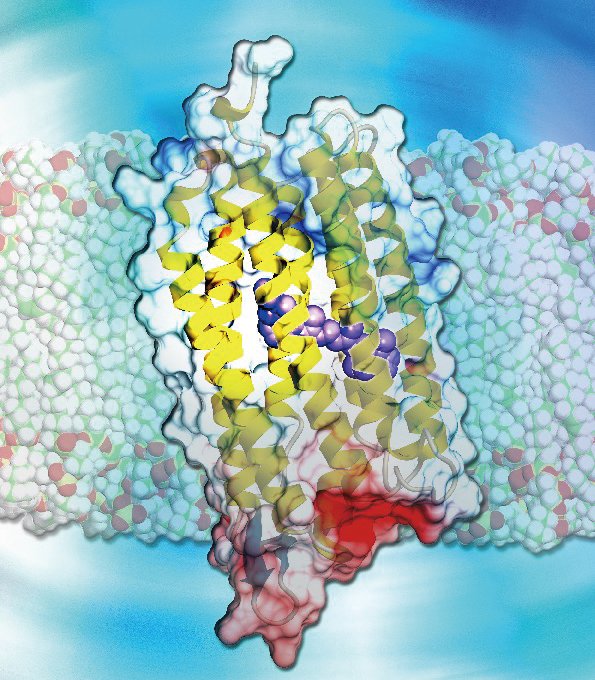
Rhodopsin contains a structure that can penetrate the cell membranes of microorganisms, and there are seven repeats of this structure; in addition, rhodopsin binds retina pigments (chromophores) to the area in the red circle shown above.
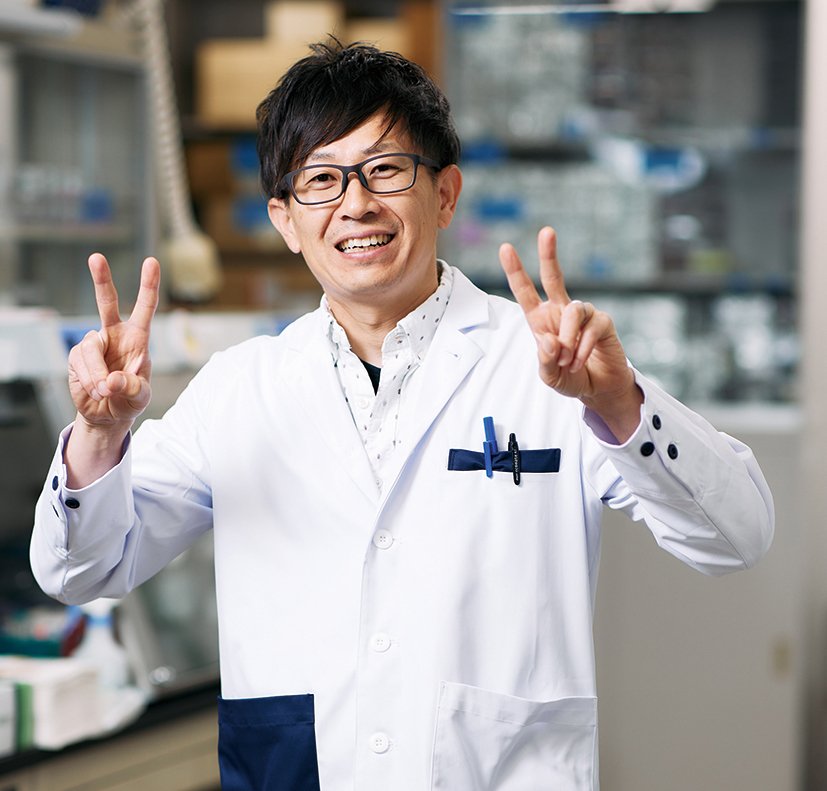
Susumu Yoshizawa
Associate Professor, Atmosphere and Ocean Research Institutes/ Department of Natural Environmental Studies
What We Can Learn from the Research
Microbial rhodopsin has the potential to be a valuable asset as both a marine and genetic resource. There may be undiscovered energy flows that do not pass through the photosynthesis process, which may have stabilized huge biomasses and rich ecosystems in the ocean. Moreover, humans may also have been influenced by them.
2.Unknown Biodiversity in Environments Around Us:
Discovery of Ultrasmall Green Alga by Genomic Analysis
Professor Sachihiro Matsunaga is an expert in molecular biology, specializing in eukaryotes. While searching for simple algae that perform photosynthesis, he identified a new ultrasmall green alga, measuring only 1 µm in diameter, by genomic analysis. He registered the new species with an international scientific community as Medakamo hakoo.
“When goldfish or medaka are kept in a water tank, algae can grow in several days and turn the water green. Over two years, we analyzed the algae found in the green water and discovered a novel micro green alga with a very basic intracellular structure. This type of algae was previously thought to inhabit only extreme environments such as craters, deep oceans, or polar regions,” explains Matsunaga.
M. hakoo, a type of freshwater green algae, contains only 7629 genes, which is the fewest among currently known algae. Its gene cluster for photosynthesis was also minimal. Through the use of fluorescence microscopy, they discovered that M. hakoo contains an oil body, which would be useful for biofuel production. Moreover, it became clear that M. hakoo evolved directly from the common ancestor of green algae.
From an evolutionary perspective, it can be understood that the minimization of M. hakoo’s genes is due to their adaptation to different environments and interactions with other organisms throughout history.
NOTE
12. Oil Body: A minute organelle for accumulating oil in cells. The mass cultivation of microalgae with oil bodies enables the production of carbon-neutral oil.
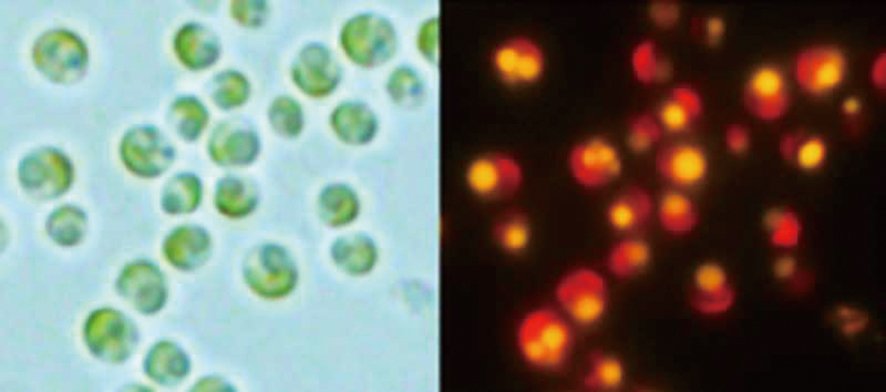
Right: An image of Medakamo hakoo obtained by fluorescence microscope: The yellow substances are oil bodies and the red substances are chloroplasts, which perform photosynthesis.
Left: An image of Medakamo hakoo obtained using a bright-field microscope
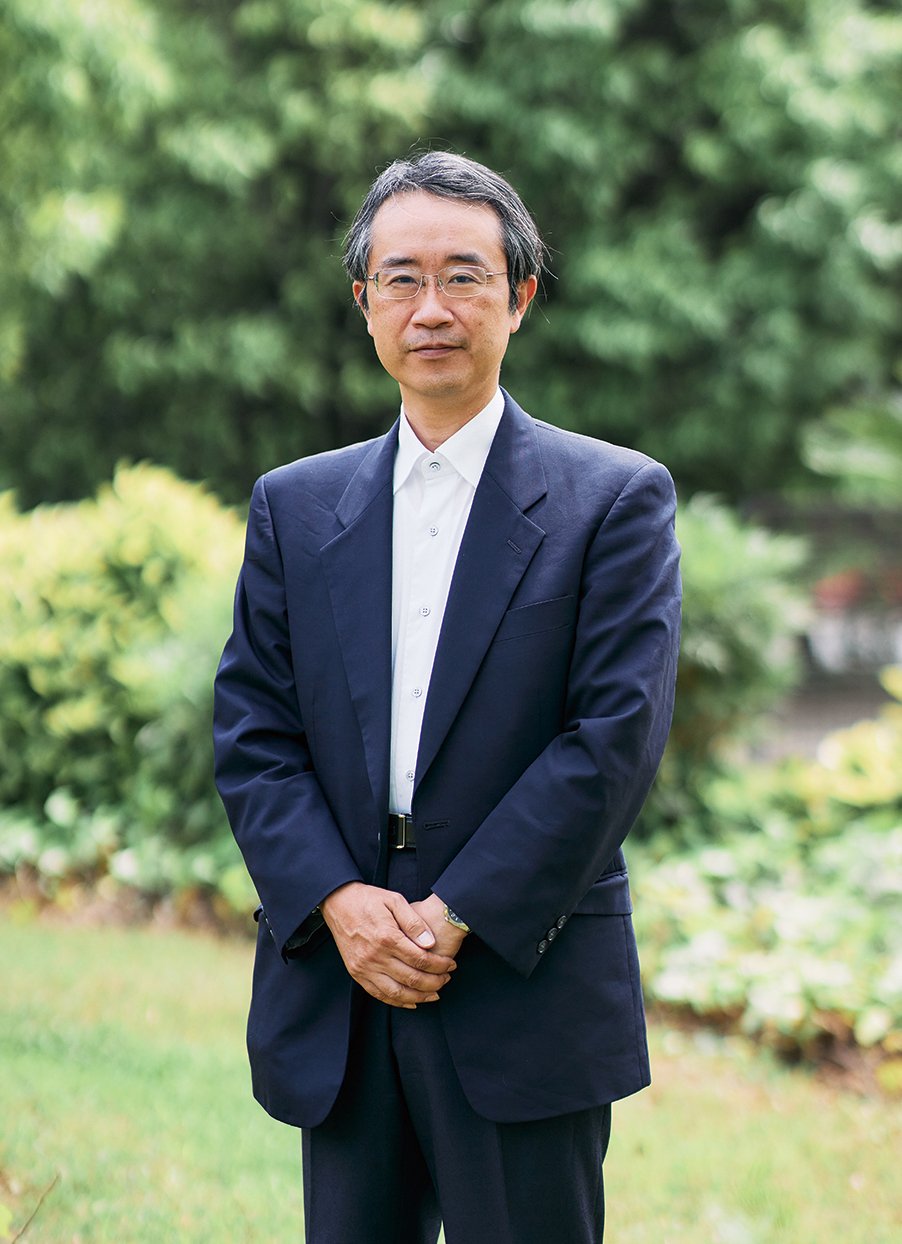
Sachihiro Matsunaga
Professor, Department of Integrated Biosciences
What We Can Learn from the Research
The genome is constantly evolving, even if the changes are not externally visible. Although we may think that we have fully investigated our surrounding environment, there is still much diversity within itself. It is important to understand that undiscovered diversity is part of an ecosystem. Altering the environment could potentially lead to the loss of undiscovered species and unforeseen outcomes. Therefore, we must understand the associated risks.
3. A New Direction for Ecosystem Preservation:
Symbiosis and Coevolution of Mycorrhizal Fungi and Plants
Professor Kazuhide Nara has dedicated many years to researching the coevolution of plants and mycorrhizal fungi. Mycorrhizal fungi are eukaryotes that form complexes called “mycorrhiza,” and include species such as the Matsutake mushroom (Tricholoma matsutake) and various truffles.
When plants first advanced from water to land, approximately 4.5 hundred million years ago, they did not have roots. Thus, it is believed that plants coexisted with mycorrhizal fungi in the ground and obtained water and nutrition from them. Some plants have a strong interdependent relationship with certain mycorrhizal fungi, and cannot survive without them.
Through isotope ratio mass spectrometry, it was found that orchids, which have the most number of species among plants, acquire carbohydrates from the mycorrhizal fungi they coexist with in addition to from photosynthesis on their own. These orchids adapted themselves to the dark forest floor environment by symbiosis. From an evolutionary perspective, we can understand how their relationship has diversified through mutual interactions since origin of the symbiotic relationship between plants and mycorrhizal fungi.
“There is a tree called togasawara (Pseudotsuga japonica), which exists only in the Kii Peninsula and Kōchi prefecture, Japan. I discovered a new mycorrhizal fungus, togasawara-shōro (Rhizopogon togasawariana), which has coevolved with togasawara tree for over 30 million years. This fungus has lived only with togasawara and has been essential for togasawara’s seedlings to take root. They are now both on the verge of extinction due to artificial forest development and other human activities,” says Nara.
He is now researching how to save plants designated as endangered species together with their symbiotic mycorrhizal fungi. We hope this concept will take root in society.
NOTE
13. Isotope Ratio Mass Spectrometry (IRMS): Isotopes are atoms that have the same atomic number but a different number of neutrons. IRMS measures the abundance ratio of stable isotopes that do not transform into another type of nuclide by radioactive disintegration. The stable isotope ratios of carbon and nitrogen found in organisms reflect the isotope ratios of the environments they grew in and the foods they consumed.

Nara breeds saplings of rare-type pines in a greenhouse on campus.
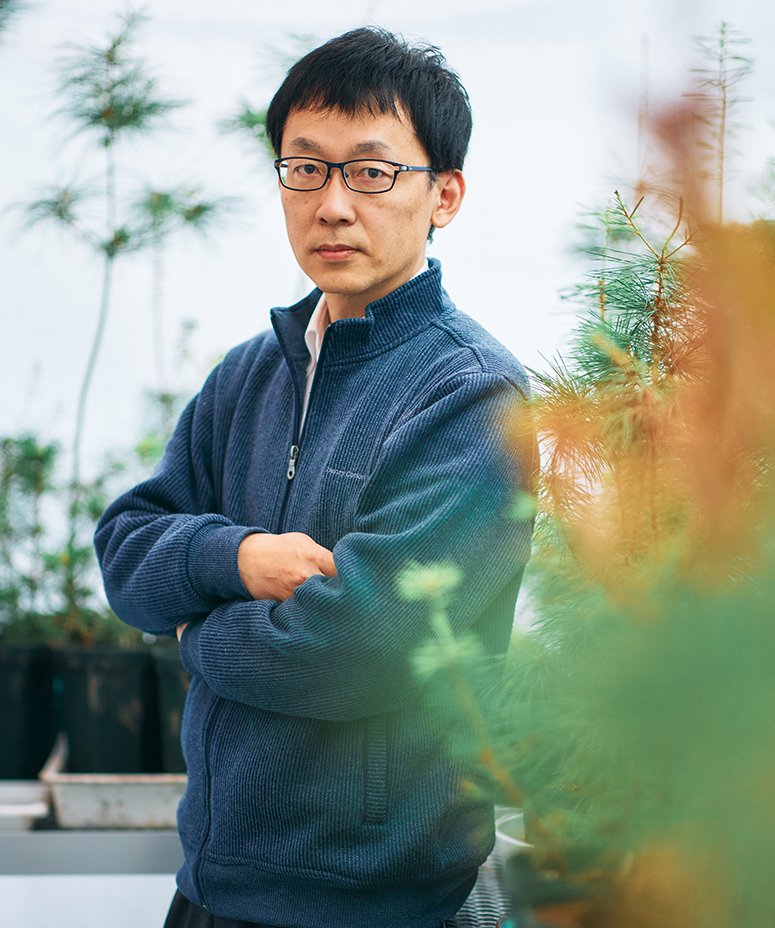
Kazuhide Nara
Professor, Department of Natural Environmental Studies
What We Can Learn from the Research
When it comes to preserving ecosystems, plants are generally the only focus, and mycorrhizal fungi are often overlooked. Moreover, the knowledge about mycorrhizal fungi has not been accumulated enough. To preserve ecosystems, it is important to consider all species, including those that have symbiotic and coevolving relationships with them.
4. Diversity Secured in Robustness:
Morphogenesis of Fruit Fly’s Legs
Organisms have evolved their shapes and forms in a various ways to adapt to the environments. Insects, for which there are over a million species, exhibit a remarkable diversity in their shapes. In the laboratory of Kojima, Associate Professor in the Department of Integrated Biosciences, they use fruit flies (Drosophilidae) to understand how the shapes of organisms are formed, how differences in shapes arise, and how shapes evolve.
Fruit flies have been one of the most commonly used model organisms for evolutionary research for more than a century. One reason to use them is that we can control the expression of specific genes in specific cells at specific times in fruit flies.
Furthermore, recent advances in research tools, such as the confocal laser scanning microscope*14 and the super-resolution microscope*15, have enabled the filming of the inner structures of living cells and tissues in cross-sections and the observing of them at resolutions of some tens of nanometers.
“Recently, we have successfully captured and observed the entire shaping process of imaginal (adult) legs of fruit flies for over several hours with long-term live imaging techniques we developed for this purpose,” says Kojima.
From an evolutionary perspective, we can understand that organisms slightly change the components and time of gene expression, retaining the basic structure and function of their body, and in this way, can flexibly adapt to their environment, which results in their diversity in their shapes.
NOTES
14. Confocal Laser Scanning Microscope (CLSM; LSCM): CLSM uses a laser as a light source and distributes serial cross-sections from the surface to the inner side of tissues without physically cutting them up. Three-dimensional images of tissues can be constructed by these cross-sectional images.
15. Super-Resolution Microscope (SRM): The resolution of SRM is as high as the electron microscope level, which the conventional optical microscope cannot reach. SRM enables the analysis of cell structures in detail.
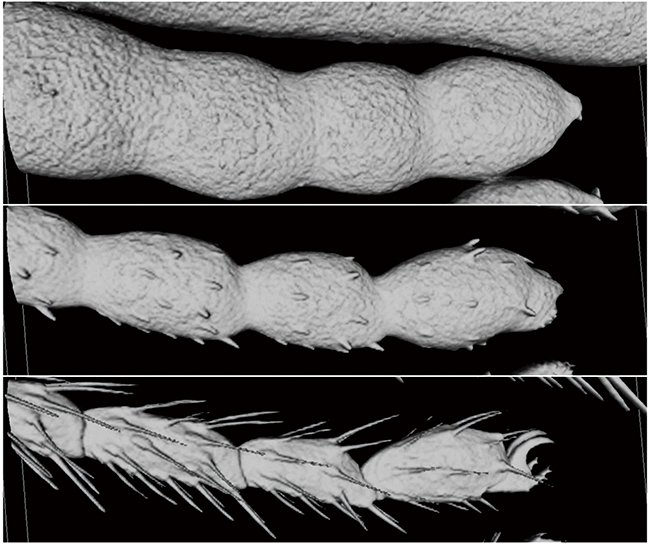
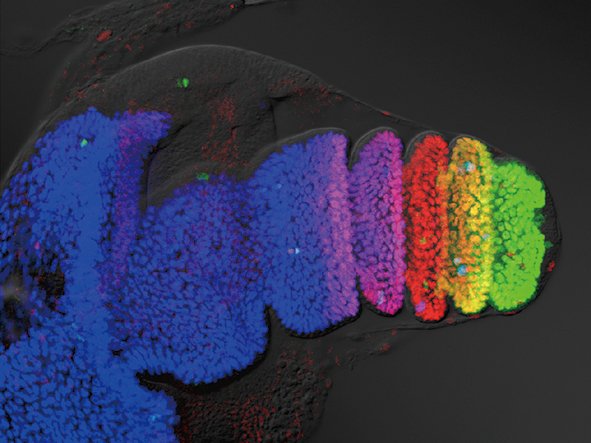
A leg of an imago(adult) fruit fly is being formed.
Gene functions at each part of a leg (coxa, trochanter, femur, tibia, and tarsus) are visible by using live imaging technology.

Tetsuya Kojima
Associate Professor, Department of Integrated Biosciences
What We Can Learn from the Research
“What changes” and “what remains the same” are exquisitely well-balanced by the mechanism of retaining the basic body structure and flexibly diversifying. Humans are not exceptional. All people are the same humans, but simultaneously, exhibiting diversified traits is a natural ability of an organism.
5. Strength Against Adversity:
Two Types of Spear Squid Male
When it comes to biodiversity, the differences in genomes and morphology within the same species or among other species garners attention. However, the diversity of the life history (the life pattern from birth to death) also contributes to biodiversity. Yoko Iwata, Associate Professor in the Department of Integrated Biosciences and Atmosphere and Ocean Research Institutes, focuses on the diversity of life histories in cephalopods, particularly in their reproduction ecology.
Environmental conditions greatly affect the life history of cephalopods in terms of growth and maturity.
“Male and female spear squid have different body features, but there are two types of males. One is bigger than a female, and the other is smaller than a female. Bigger males fight over a female. When the winner pairs with the female, a small male sneaks in between the pair and ejects sperm to a different part of the female’s body than the big one the winner. Moreover, there was a new discovery that the sizes of sperm are different between big males and small males. There are no other organisms that have two types of sperm in a species,” explains Iwata.
Squids have hard tissues, known as statoliths, which show marks of daily growth. The water temperature a squid has experienced in the past can be identified by “trace element analysis” of the strontium/calcium constituent ratio in the statolith.
Their features and the dimorphism (two types) in males occurring in their life history are considered to be greatly influenced by differences in seasons, sea areas, sea depth, and seawater temperature at birth and during the growing process. Many species of insects and fish also have dimorphism within a sex but their traits are diverse.
Questions from an evolutionary perspective, namely which environmental conditions and natural selection make the life history diverse, can be good research themes to explore.
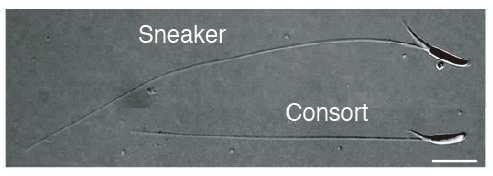
Sperm of a small-type spear squid (sneaker) and of a big-type squid (consort)

Yoko Iwata
Associate Professor, Atmosphere and Ocean Research Institutes/Department of Integrated Biosciences
What We Can Learn from the Research
Spear squid that do not have the advantage of growing big reach maturity at a smaller size and reproduce differently than those that have the advantage. They teach us that there is not only one way to survive.
6. Humans’ Influence on Extinction:
The Evolutionary History of Vertebrates Through Fossil Research
Mugino Kubo, a lecturer in the Department of Natural Environmental Studies, leads a research group studying the fossils of mammals and dinosaurs. The focus of their research is to analyze the microscopic characteristics of teeth and bones. They studied the life history of deer all across Japan, which included extant sika deer (Cervus nippon) and the extinct Ryukyu dwarf deer (Cervus astylodon) using a bone histology technique*16 developed in dinosaur research. The results showed that the longer these deer were isolated on an island without predators, the slower they matured and the longer they lived compared to their counterparts.
“I estimate that large-size mammals isolated on islands have evolved a ‘slow lifestyle,’ which makes these animals require longer to be sexually matured. Therefore, once their population gets diminished by humans, the risk of extinction becomes higher,” says Kubo.
Furthermore, she investigates whether small animals that became bigger due to isolation on an island have a “slow lifestyle.”
Kubo uses a confocal laser scanning microscope. This laser microscope was developed in the material science field. It can measure the roughness and smoothness of the texture of the material surface nondestructively and accurately. Using a laser microscope, she estimates the diets of vertebrates from patterns of microscopic scratches on the surfaces of their teeth.
Paleontology is often categorized as a geological science, and fossil research does not necessarily focus on evolutionary phenomena and their factors. However, if we consider paleontology as a part of evolutionary biology, we can gain a long-term perspective on organism evolution. Moreover, we can understand how organisms have adapted themselves to drastic and incredible changes in the environment in the past.
NOTE
16. Bone Histology: Bone histology is a method used to analyze an individual’s growth rate from birth to death. The process involves slicing the bones of recent animals or fossils into sections of tens of microns in thickness and measuring the growth ring-like traces of body development through a polarization microscope.
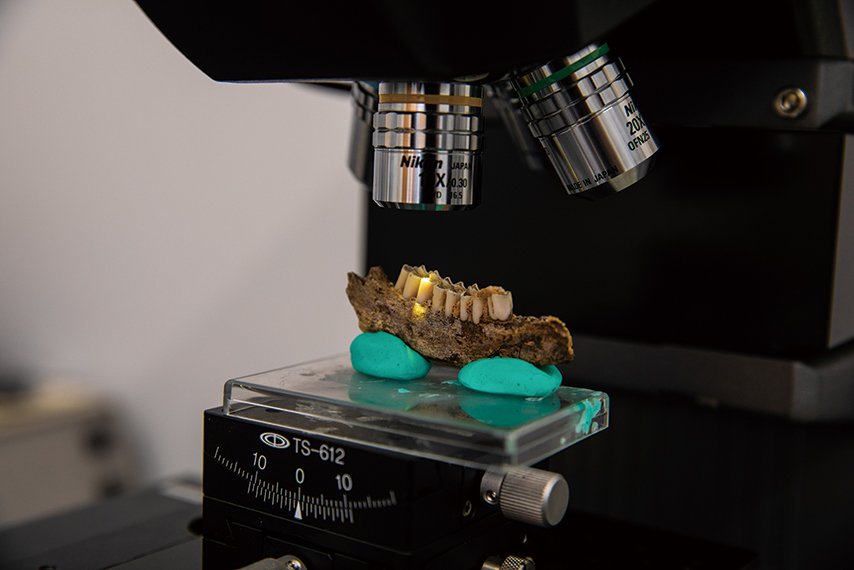
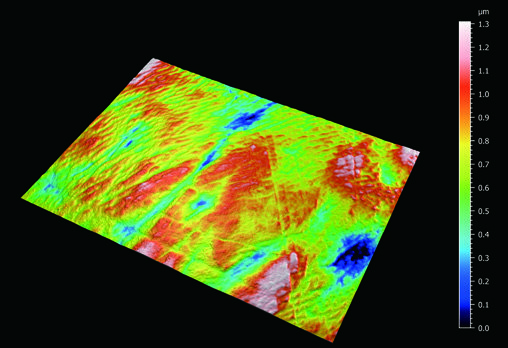
Top: The confocal laser scanning microscope
Down: A 3D model of the micro surface of teeth acquired from the microscope: The image is of a micro area of 100μm x 140μm. The colors indicate the roughness.

Mugino Kubo
Lecturer, Department of Natural Environmental Studies
What We Can Learn from the Research
Through fossil research, we can understand that a new ecosystem develops when mass extinction has occurred and that organisms are intrinsically resilient. However, human expansion to various land areas has caused the extinctions of many species, particularly on islands where the ecosystem can easily be isolated. Knowing which human activities accelerate extinction helps us take action to protect endangered species and prevent their complete eradication.
7. Human “Color Vision Deficiency” Is Not a Deficiency:
Primates’ Color-Vision Diversity
Professor Kawamura has been studying the sensory genes of vertebrates, specifically, the evolution of primates’ color vision. In the retina of vertebrates, there are color-sensing cells called cone photoreceptor cells, and opsins (photosensors) are in operation there. Vertebrates’ basic color vision is a high-level color vision called tetrachromacy, consisting of four opsin types. Mammals lost two types of the four opsins and developed dichromacy, which consists of the remaining two opsins, short-wavelength sensitive opsin (S-opsin) and long-wavelength sensitive opsin (L-opsin). These are considered an adaptation to the nocturnal habit during the dinosaur era. However, unlike other mammals, primates differentiated medium-wavelength sensitive opsin (M-opsin) from L-opsin and acquired three opsins: L-, M-, and S-opsin.
It has been considered an adaptation of primates upon acquiring the niche on the trees in the forest during the Cenozoic era after the dinosaurs became extinct. Meanwhile, there is also a significant diversity of dichromacy and trichromacy in the monkeys in Central and South America. Kawamura conducted fieldwork in Costa Rica and analyzed genes of color vision opsins extracted from the feces of monkeys. He discovered that trichromacy is useful for spotting ripe fruits that change color from green to red or yellow, while dichromatopsia is better for detecting insects that blend into their surroundings.
“Dichromatic and trichromatic types both have contour vision. However, L-M color vision information processing, which is unique to the trichromatic type, uses the same neural circuits as contour vision in the retina. Therefore, when contour vision is important, such as when catching insects, trichromatic vision works adversely,” explains Kawamura.
The mechanisms of human vision also have diversity in another way from those of monkeys. Nevertheless, the dichromatic type in humans is considered a “color deficiency,” even though one in twenty males has it, regardless of race or occupation.
From an evolutionary standpoint, it is apparent that “color deficiency” originated before the migration of Homo sapiens out of Africa. For life in that era, contour vision might have been more important than trichromacy in some situation where humans needed to hunt in environments like the Savanna.
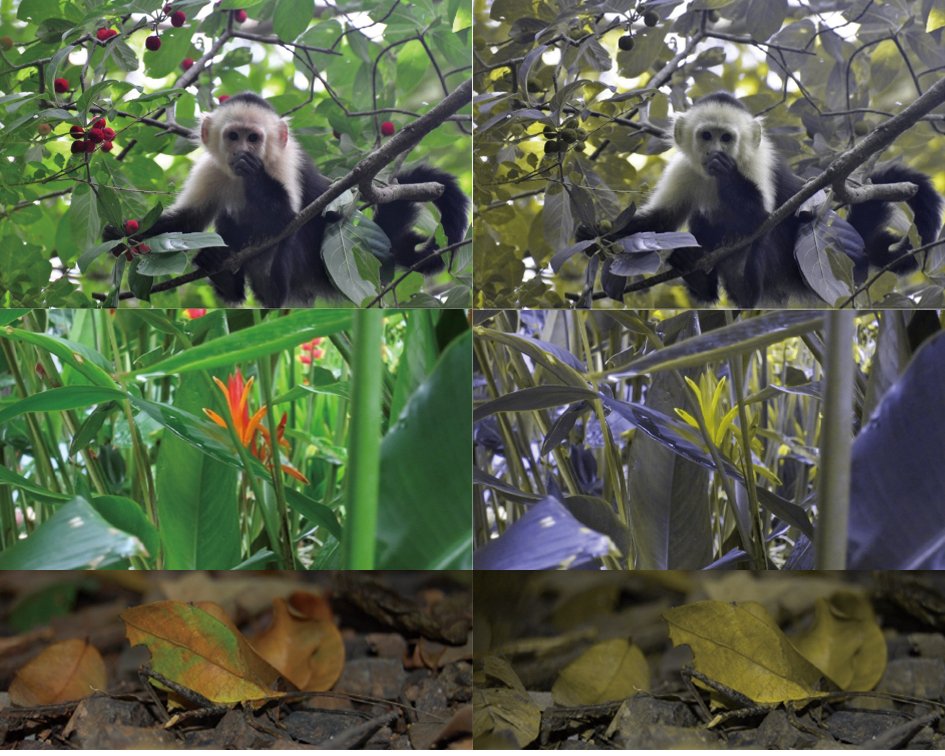
Left: An example of the trichromatic view
Right: An example of the dichromatic view
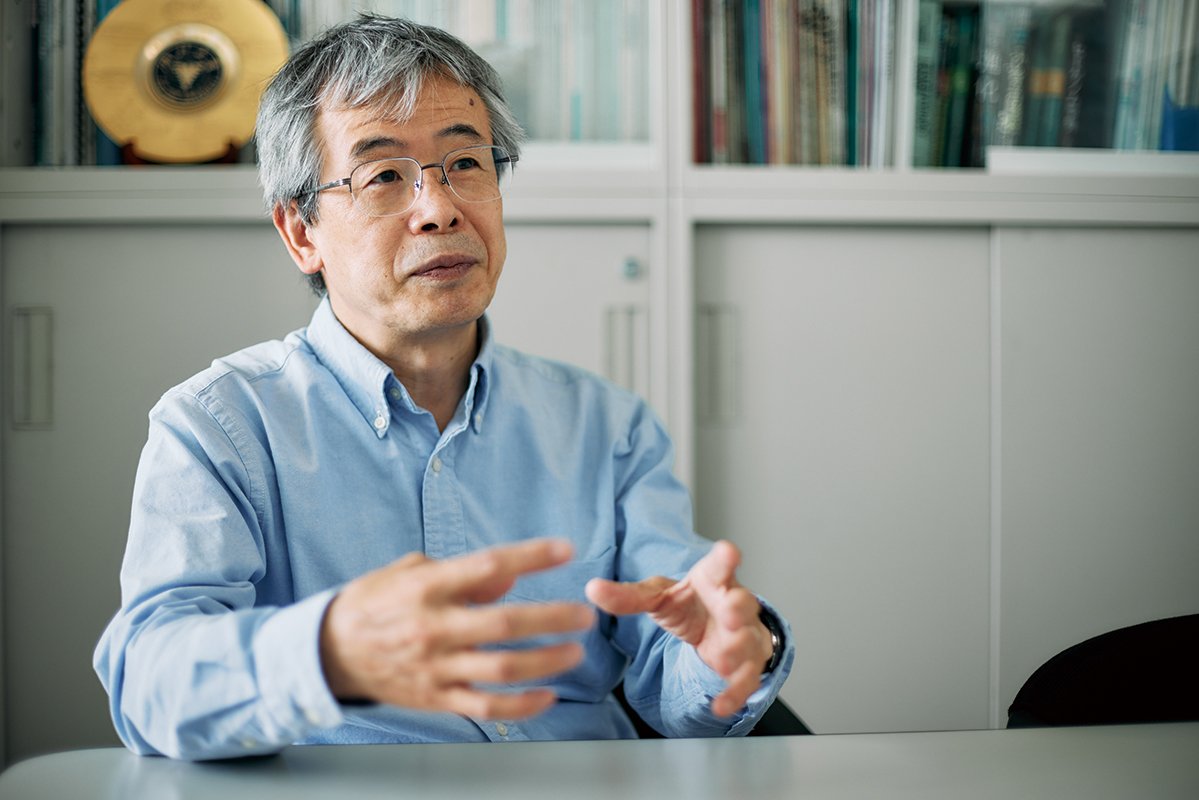
Shoji Kawamura
Professor, Department of Integrated Biosciences
What We Can Learn from the Research
What may appear as a “deficiency” can be considered “diversity.” To categorize the dichromatic type in humans as a deficiency is a caution against normal–abnormal dichotomy in seeing diversity or discrimination and exclusion of minorities.
COLUMN
An Evolutionist’s Curiosity And Relationship with Society
I first became interested in evolution when I was in the fifth grade of elementary school. My twin sister and I are both dedicated to evolutionary research now. Evolutionary biology is a field that seeks to uncover the secrets of where organisms came from, what they are, and where they are headed. Many evolutionists are driven by a strong curiosity to solve these mysteries.
Humans are presently facing various problems. By studying evolution, one of the fundamental sciences, we can gain a broader and more objective understanding of humanity. I believe that these perspectives can provide valuable insights and suggestions for society.
Having recently become a parent, I want to share my research experiences and messages to create a society that respects one’s desire to learn and nurtures diverse curiosities.

Asano Ishikawa
Associate Professor, Department of Integrated Biosciences

Ishikawa collects old books on evolutionary biology. Her collection includes guides to evolutionary biology published in the Meiji era.
Intellectual Stimulation and Lessons from Evolutionary Research
Although it is possible to conduct the research we presented in the cover story without considering an evolutionary viewpoint, incorporating an evolutionary perspective alongside cutting-edge technology and new research methods, may lead to a different understanding of the world. Evolutionary research not only stimulates intellectual curiosity, but also shows us the essence of evolution, diversity, coexistence, and ecosystems.
vol.42
- Cover
- What We Can Learn from the Frontier of Evolutionary Biology
- My Dream Is to Create Energy for the Perpetual Survival of Humans
- Interdisciplinary Approach to Molecular and Ecological Sciences to Unravel the Secret of Biodiversity
- Science for Balancing Biodiversity and Human Needs
- GSFS FRONTRUNNERS: Interview with an entrepreneur
- Voices from International Students
- ON CAMPUS x OFF CAMPUS
- EVENTS & TOPICS
- Awards
- INFORMATION
- Relay Essay

